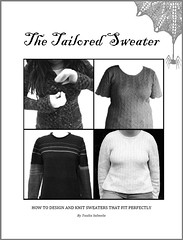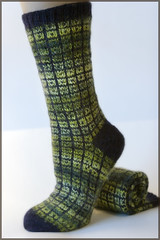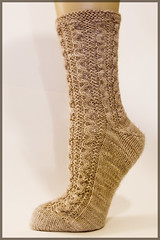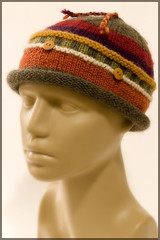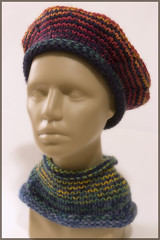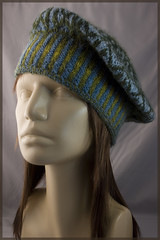[
I’m the President of a knitting guild in Snohomish county, Washington. I write a small article in each newsletter, and I’m repurposing this one I wrote for the July publication.]

My fiber work in June took an unexpected turn when I mis-read a contract and thought the design I was doing was intended for a June
2011 audience. After weeks of work and when all aspects of the project appeared to be going south, I contacted the publisher and declined the project only to find out that pattern packages had already been sold and hundreds of people were waiting as it was a June
2010 project. Oh, my! All my commitments were cancelled, obligations of walking the dog and doing the laundry were foisted off on my partner, and I hunkered down to get the job done. The only thing about the project that saved my sanity was the fact that it was still fun, despite the miscommunication and subsequent late night work, because it was a
colorwork project.
Color has the ability to delight and amaze. Placing yellow next to blue next to coral and accenting with black can be the saving grace of the dreaded second sock syndrome. (DSSS: when the first sock was great and now I have to knit a second one?) You can spend your life calmly knitting color stripes, varying only the hues and never changing the stitch pattern, and still make a lifetime‘s worth of amazing garments.
The world of software has provided us with tools to make color designing and experimentation easier and even more fun. Try a few of these out:
Color Palette Generator. Enter the URL of an image to get a color palette that matches the image. Generate that palette from almost any image you see on the Internet by right clicking on the image, selecting ―properties, then select and copy the address listed (ends in .jpg or .gif).
COLOURlovers is a creative community where people from around the world create and share colors, palettes and patterns. View hundreds of thousands of color palettes.
For your iPhone:
ColorExpert. Use a photo on your iPhone to generate a palette. Although this app is expensive as far as iPhone apps go ($9.99), it offers maximum control to generate your palette. The output includes RGB, Hex, and Pantone codes to enable you to duplicate the colors via print or the Web. You'll have to wing it for your dyepots! Here are two examples of the palettes generated by ColorExpert with some of my photos:
Sherwin Williams ―
ColorSnap is a free app that also generates a palette from a photo on your iPhone, but with less control.
On July 13 Abbott Smith spoke to the guild about how he tames the color beast. He shared more fascinating ways to play with the magic of color. How will color save you?
Let‘s knit!
Charisa

















